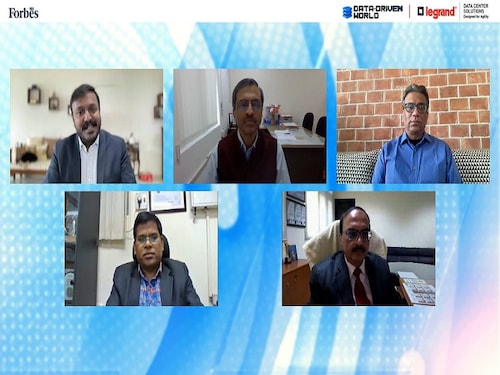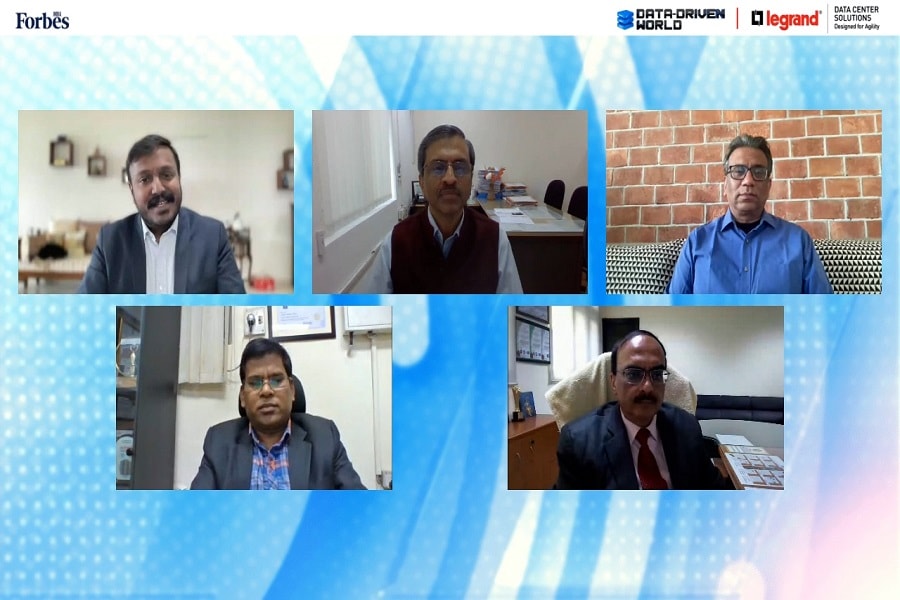Forbes India & Legrand data center present 'data driven world'
The Indian Data Center is growing at a rate of 11.4%, and this demand will continue to increase with services in cloud adoption


 The government of India has undertaken various digitalization efforts as part of its larger goal of creating a "Digital India," which has accelerated the pace at which Indian enterprises are adopting cloud computing and other forms of digital transformation. As more programmes like G2C distribution channels, National e-Governance set-up, e-visa, and National CSR efforts are pushed out across the country, the need for data centres is likely to expand tremendously.
The government of India has undertaken various digitalization efforts as part of its larger goal of creating a "Digital India," which has accelerated the pace at which Indian enterprises are adopting cloud computing and other forms of digital transformation. As more programmes like G2C distribution channels, National e-Governance set-up, e-visa, and National CSR efforts are pushed out across the country, the need for data centres is likely to expand tremendously.
The Indian Data Center is growing at a rate of 11.4%, and this demand will continue to increase with services in cloud adoption, digital transformation, and social media usage. What role do the government sectors play in the data centers? To discuss this and more, Forbes India and Legrand Data Center Present "Data Driven World", a webinar moderated by Manu Balachandran and speakers like Mr. Sharat Sahai, GM at CRIS, Dr. Prashant Atrey, HoD IT&C, NHPC Ltd, Mr. Golok Kumar Simli, Principal Advisor & CTO, Passport Seva, and Mr. Sanjay Motwani, Business Head at Legrand Data Center Solutions.
India is facing a surge in demand for transformation for its first-gen e-governance services harnessing the power of new technologies such as cloud, Big Data, AI, etc. What factors are driving this demand? Sharing his thoughts on this Mr. Sanjay said, "I believe two factors are driving this demand first is the consumer, and second is government. Today"s consumer has become the demanding consumer. Everything has to be available at the top of a click. Organizations are trying to play catch up to keep up with these demands. On the other side, the government"s Digital India initiatives, activities rolled out, smart cities, e-commerce, digital payments, etc are playing a lot in driving the data. Hence the need for data centers."
Government offers its services pan education, healthcare, identity, and payments. How are data centers driving the change toward Digital India? Sharing his thoughts, Mr. Golok said, "I see 3-4 directions why hybrid data centers are so important for our services. One particular aspect is delivering all the services nearest to the user, especially in the remotest parts of the country. Today, it"s no longer about data travelling to the computer but the other way around.
The second shift we have observed is that post-COVID, demand and expectations for devices to access government services are 24/7. Virtually, we have gone ahead boundariless today there is no such thing as a corporate data center. With the shift towards the cloud, the government is looking at two things: how to migrate the workload to the cloud, and while migrating do we have a data strategy in place? Going forward, I believe there will be a close collaboration between the government and industry while developing a phygital or hybrid interface."
Did COVID-19 impact the government ecosystems? Sharing his thoughts, Mr. Golok said, "There has been a cultural shift which we have observed. To establish a digital ecosystem, the key imperative is to understand what the citizen expects from us. It"s not only about the ministry but also involves the users, media, etc. How do you meet the demand and democratization?"
With over 8000 stations spread across a vast network, the Indian Railways continues to strive to enhance the passenger experience backed state-of-art amenities backed by technology. How is the ecosystem being transformed by railways? Sharing his thoughts, Mr. Sharat said, "Indian railways caters to a large number of passengers - not just those who commute but also freight passengers. The freight that we carry with 50% being coal, steel, cement, and higher-value consignments amongst others - this is what touches everyone"s lives.
The passenger is becoming demanding in terms of the information they require. We are now looking at the entire lifecycle of the passenger or consignment journey, where information needs are changing at every point. This is what we want to address. There is a lot of computing going on in the background. We are doing one crore data changes daily. The need for IoT and cyber-security systems has also arisen. The automated data is captured from our locomotives and coaches segment. This has led to the need for edge-data centers."
How is NHPC enabling AI and identifying potential risks? Dr. Prashant said, "Our plans are concentrating on IT systems and catering to local computer system requirements.AI systems are not in place but other cybersystems are used to protect dashboards, MIS, and more. We are looking to adopt SaaS-based solutions."
Investments in the Indian data center market in the APAC region are expected to reach $4.6 billion by 2025. What are the regulations to ensure data centers operate at certain efficiency to maintain sustainability? Mr. Sanjay Motwani shared his thoughts and said, "The main challenge is to build sustainable data centers by design, they"re not sustainably friendly. Putting in policies and regulations where sustainability metrics or operational efficiency metrics are present is very critical. Singapore had to pull the plugs to meet the metrics. Going forward having regulations will be helpful."
Indian railways have 100 use cases but, the question remains. With the need for data processing, the need for edge processing, reliance on third-party cloud to take on the workload, and migrating to hybrid data centers, the government sector is playing a massive role in driving data adoption.
Watch the full session here https://youtu.be/z7j68lgIz1E
The pages slugged ‘Brand Connect’ are equivalent to advertisements and are not written and produced by Forbes India journalists.
First Published: Dec 26, 2022, 17:39
Subscribe Now